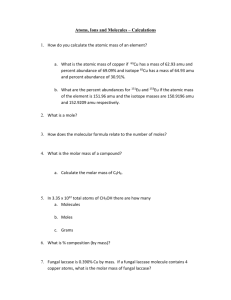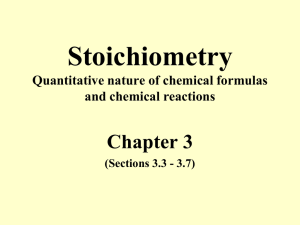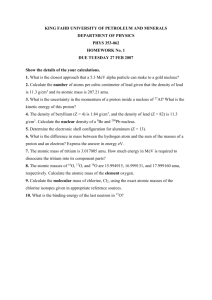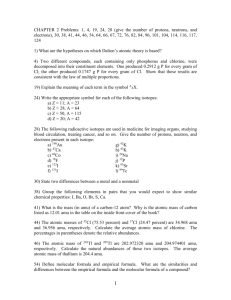Advanced Chemistry Activity Name
advertisement
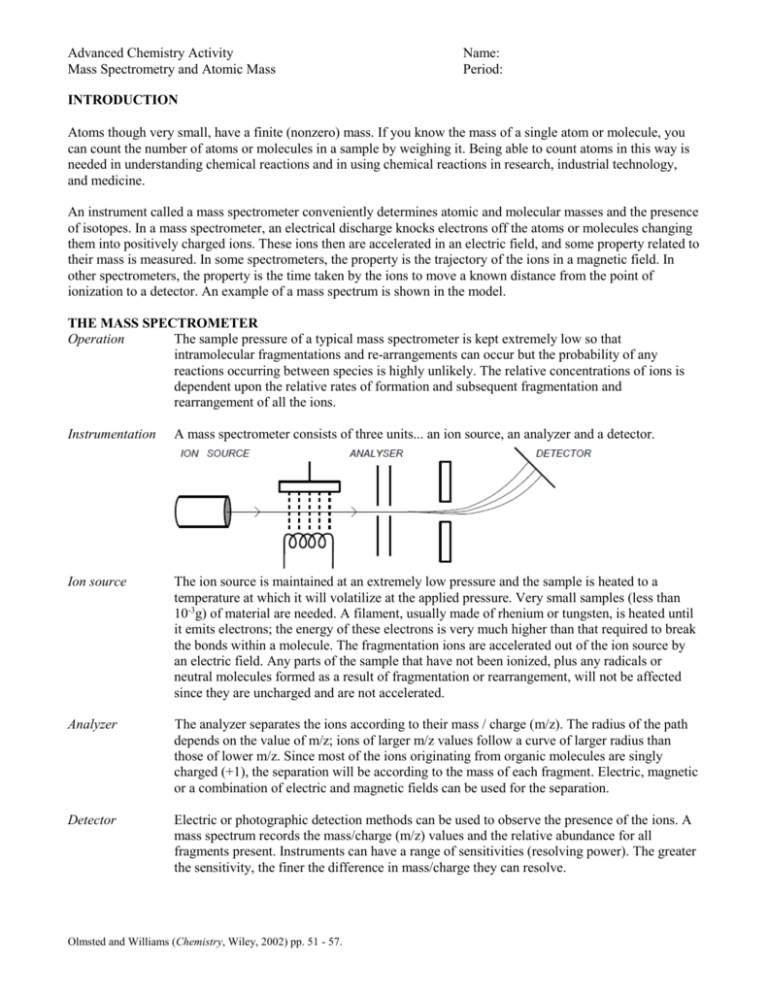
Advanced Chemistry Activity Mass Spectrometry and Atomic Mass Name: Period: INTRODUCTION Atoms though very small, have a finite (nonzero) mass. If you know the mass of a single atom or molecule, you can count the number of atoms or molecules in a sample by weighing it. Being able to count atoms in this way is needed in understanding chemical reactions and in using chemical reactions in research, industrial technology, and medicine. An instrument called a mass spectrometer conveniently determines atomic and molecular masses and the presence of isotopes. In a mass spectrometer, an electrical discharge knocks electrons off the atoms or molecules changing them into positively charged ions. These ions then are accelerated in an electric field, and some property related to their mass is measured. In some spectrometers, the property is the trajectory of the ions in a magnetic field. In other spectrometers, the property is the time taken by the ions to move a known distance from the point of ionization to a detector. An example of a mass spectrum is shown in the model. THE MASS SPECTROMETER Operation The sample pressure of a typical mass spectrometer is kept extremely low so that intramolecular fragmentations and re-arrangements can occur but the probability of any reactions occurring between species is highly unlikely. The relative concentrations of ions is dependent upon the relative rates of formation and subsequent fragmentation and rearrangement of all the ions. Instrumentation A mass spectrometer consists of three units... an ion source, an analyzer and a detector. Ion source The ion source is maintained at an extremely low pressure and the sample is heated to a temperature at which it will volatilize at the applied pressure. Very small samples (less than 10-3g) of material are needed. A filament, usually made of rhenium or tungsten, is heated until it emits electrons; the energy of these electrons is very much higher than that required to break the bonds within a molecule. The fragmentation ions are accelerated out of the ion source by an electric field. Any parts of the sample that have not been ionized, plus any radicals or neutral molecules formed as a result of fragmentation or rearrangement, will not be affected since they are uncharged and are not accelerated. Analyzer The analyzer separates the ions according to their mass / charge (m/z). The radius of the path depends on the value of m/z; ions of larger m/z values follow a curve of larger radius than those of lower m/z. Since most of the ions originating from organic molecules are singly charged (+1), the separation will be according to the mass of each fragment. Electric, magnetic or a combination of electric and magnetic fields can be used for the separation. Detector Electric or photographic detection methods can be used to observe the presence of the ions. A mass spectrum records the mass/charge (m/z) values and the relative abundance for all fragments present. Instruments can have a range of sensitivities (resolving power). The greater the sensitivity, the finer the difference in mass/charge they can resolve. Olmsted and Williams (Chemistry, Wiley, 2002) pp. 51 - 57. Advanced Chemistry Activity Mass Spectrometry and Atomic Mass Name: Period: INTERPRETATION OF SPECTRA Isotopes One of the first applications of the mass spectrum was the demonstration by F.W. Aston, (Nobel Prize winner in 1922), that naturally occurring neon consisted of three isotopes ... 20Ne, 21Ne and 22Ne. By comparing the positions of the peaks, one can calculate the atomic mass. In addition, the relative abundance of each isotope can be found by comparing the peak intensities. MODEL: DATA ON ATOMIC MASSES Ion Counts per second In a mass spectrum the number of ion counts over some period of time is plotted on the y-axis with the atomic mass on the x-axis. The number of ion counts for different isotopes is proportional to the abundance of each isotope in the sample. Since atomic masses are so small, a special mass unit is used. This unit is called the atomic mass unit and is abbreviated amu. The atomic mass unit is defined so the mass of carbon-12 is exactly 12 amu. The masses of all other atoms then are measured on relative to the mass of carbon-12. The factor for converting grams to amu is 1.66054x10-24 g/amu. SI (x) % Mass in amu Mass Spectrum of Boron Olmsted and Williams (Chemistry, Wiley, 2002) pp. 51 - 57. Advanced Chemistry Activity Mass Spectrometry and Atomic Mass Atomic Isotope hydrogen Symbol 1 1H Name: Period: Table of Isotopic Data Atomic Mass (amu)* 1.0078 Natural Abundance on Earth(%) 99.985 2 1H 2.0140 0.015 helium 4 2 He 4.00260 100.0 boron-10 10 5B 10.0129 19.78 boron-11 11 5B 11.0093 80.22 carbon-12 13 6C Exactly 12 by definition 98.89 carbon-13 13 6C 13.0034 1.11 bromine-79 79 35 Br 78.9183 50.54 bromine-81 81 35 Br 80.9163 49.46 deuterium KEY QUESTIONS 1. What mass unit is used to report the mass of atoms in the model? 2. How is this unit defined? 3. Are the mass number and the mass of an isotope (in amu units) exactly or only approximately the same? 4. Why is it more convenient to use atomic mass units (amu) rather than grams or kilograms (g or kg) in reporting atomic masses? 5. Why is one peak in the mass spectrum for boron higher than the other? 6. What are the differences and similarities between isotopes of the same element? 7. If an element has several isotopes, what single value for the atomic mass could be used to characterize that element? Justify your answer. Olmsted and Williams (Chemistry, Wiley, 2002) pp. 51 - 57. Advanced Chemistry Activity Mass Spectrometry and Atomic Mass Name: Period: EXERCISES 1. Show that the peak heights in the boron mass spectrum, shown in the model, are consistent with the natural abundances given in the Table of Isotopic Data. 2. Draw a sketch to show what you expect the mass spectrum of bromine to look like. 3. If you could pick one carbon atom out of a natural sample, identify what its mass most likely would be. Explain. 4. Determine the number of boron-11 atoms that you would expect to find in a natural sample of 10,000 boron atoms. Ion Counts per second PROBLEMS 1. Obtain as much information as you can from the mass spectrum for nickel shown below. SI (x) % Mass in amu Olmsted and Williams (Chemistry, Wiley, 2002) pp. 51 - 57. Advanced Chemistry Activity Mass Spectrometry and Atomic Mass Name: Period: 2. (a) The atomic mass of an isotope is 64.9278 amu. How many atoms are there in exactly 1 kg of this isotope? (b) Since the mass of carbon-12 is defined as 12 amu, how many atoms are there in exactly 12 g of carbon-12? 3. In a nuclear fusion reaction, two deuterium atoms combine to produce one helium-4 atom. Is mass conserved in this reaction? Explain. Olmsted and Williams (Chemistry, Wiley, 2002) pp. 51 - 57.





